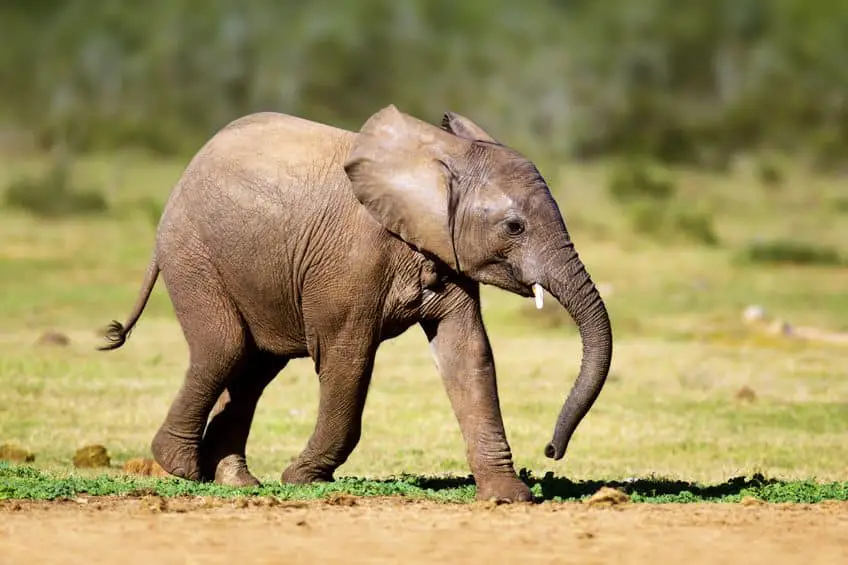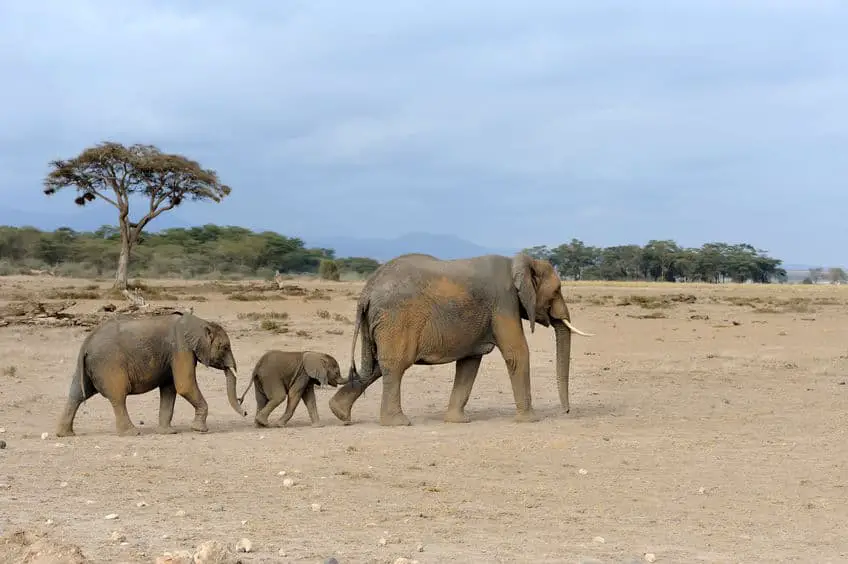
There are three stages in an African elephant’s life and like with all other animals, it begins with the baby stage and that is exactly what this post is about. How African baby elephants are born and raised.
So how are baby elephants born and raised? When an elephant calf is born, all members of the herd surround the mother to protect her and the calf. The calf is then raised by the mother with help from the rest of the herd until it reaches adolescence.
Below I have gone into much more detail and described how elephant calves come into the world and how they are raised for the first part of their life.
The First Years Of An Elephant’s Life
Before we dive into how baby elephants (called calves) are born and raised, it is important to know the very basics of their social structure since this plays a very significant role in the calves’ lives.
Male elephants (called bulls) are generally solitary in nature and usually live on their own. They can, however, socialize with other bulls and form temporary groups (called herds). Female elephants (called cows) on the other hand live in herds consisting of the other cows from their family and their calves. Herds of elephants therefore usually consist of elephant cows and calves that are all related to each other. A herd usually includes mothers, grandmothers, aunts, and cousins.
Before an elephant calf is born, the mother goes through a gestation period of 21-22 months which is the longest gestation period of any animal on the planet.
When it is time for the mother to give birth, the other members of the herd will surround the soon-to-be mother. They do this to protect the cow giving birth and the newborn calf in case, there are some hungry predators nearby waiting for an easy meal.
After successfully giving birth to the little new elephant calf, the herd is officially one member larger and the calf is part of a big and strong family that will provide protection and raise the calf to one day be large and strong enough and have the skills to either survive on its own or to take on a stronger role in the herd and help to raise new calves.
At birth, the calf weighs between 90-120 kg. (200-265 lb). It is covered in long hairs all over its body which serves the purpose of carrying heat away from the calf’s skin and help it stay cold and not overheat in the strong African sun. Over time as the calf grows, it will gradually lose this hair.
The newborn calf is almost blind and has pretty much no control over its body. Especially the calf’s long trunk can cause trouble in the beginning since the calf has no idea how to control it and will often experiment and play around with it, swinging it from side to side and in circles. The young calf is so unused to having to control its body and its trunk, that it will often trip over its own trunk and fall.
After just a few hours, however, the calf will already have learned how to walk and move around although it is still not very good at it and will seem very clumsy for a while after being born. It will quickly get to develop and practice this important skill though and around the age of 1 year, the calf will be able to walk and use its trunk almost like the adults.
Until then, however, despite causing the occasional trouble, the trunk still serves a very important purpose for the young calf as it is used to feel and smell things around it.
The elephant calf is born without its tusks but it does not take long before they start growing and eventually, they will become very useful tools for digging for water, stripping bark off trees, and breaking branches which provides an important source of nutrients for the calf later in its life. The tusks will usually start growing within the first year of the calf’s life.
For roughly the first 2 years, the elephant is fully dependant on the nutrients from the milk from its mother. After the first 2 years, the calf will slowly start adding plants to its diet and will consume these alongside the milk from its mother. This diet will go on for the next few years (usually until the age of 5-10) after which the calf will no longer consume its mother’s milk and now gets all of its nutrients from various plants like the adults.
While the calf is still in the baby stage and until it reaches adolescence, it will stay in the herd with the females and other young elephants from its family. During this time it will benefit enormously and learn a tremendous amount of important life skills from having all these extra caregivers around it. It will observe and try to imitate the behavior of the older elephants from the herds until it one day becomes sufficiently good at all the things needed to survive on its own or to help to raise new, young calves.
The young calf will be raised by its mother with assistance from the other members of the herd. In the very unfortunate case that the calf’s mother should get sick or die, another member of the herd will take over as the primary caregiver and take care of the calf as if it was her own.
Reaching Adolescence

Around the age of 10-13, the young elephant will reach sexual maturity. At this point is has survived the baby stage and acquired and started to practice several important skills. The elephant has officially reached adolescence and is no longer a calf.
Adolescence is a very important stage of the young elephant’s life since it will acquire and practice many important skills necessary for surviving and thriving that it has not yet had a chance to practice during the baby stage of its life.
Young male elephants will leave their herd once they reach adolescence. They are very sociable at this point in their life and will seek out other young male elephants or older bulls and form temporary herds.
These herds can become huge and consist of upwards of 100 elephant bulls but they are only temporary and are much less stable than the family herds consisting of cows and calves. While in these massive herds of bulls, the young elephants will observe each other and learn from each other, especially from the older, more experienced bulls.
Once the bulls reach a certain age, they tend to be more solitary in their nature and will often wander off and live on their own. These bulls get so massive and so strong that they do not have many natural enemies and they can easily take care of themselves at this point.
Young elephant cows will stay in their family herd for the rest of their lives. Once they reach adolescence, they will start taking on a stronger role in the herd where they will help with taking care of and raising new calves. This will allow them to learn and practice the skills needed for when they become old enough to have calves of their own.
If you are interested in learning more about the different stages of an African elephant’s life, I have written this post about their life cycle from birth to death.

